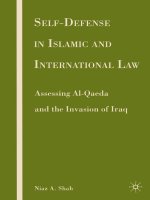Understanding international law
Bạn đang xem bản rút gọn của tài liệu. Xem và tải ngay bản đầy đủ của tài liệu tại đây (2.03 MB, 488 trang )
Understanding
International Law
Conway W. Henderson
WILEY-BLACKWELL
Understanding International Law
Understanding International Law
Conway W. Henderson
A John Wiley & Sons, Ltd., Publication
This edition first published 2010
© 2010 Conway W. Henderson
Blackwell Publishing was acquired by John Wiley & Sons in February 2007. Blackwell’s publishing program has been merged with Wiley’s global Scientific, Technical, and Medical business to form Wiley-Blackwell.
Registered Office
John Wiley & Sons Ltd, The Atrium, Southern Gate, Chichester, West Sussex, PO19 8SQ,
United Kingdom
Editorial Offices
350 Main Street, Malden, MA 02148–5020, USA
9600 Garsington Road, Oxford, OX4 2DQ, UK
The Atrium, Southern Gate, Chichester, West Sussex, PO19 8SQ, UK
For details of our global editorial offices, for customer services, and for information about
how to apply for permission to reuse the copyright material in this book please see our website at www.wiley.com/wiley-blackwell.
The right of Conway W. Henderson to be identified as the author of this work has been
asserted in accordance with the Copyright, Designs and Patents Act 1988.
All rights reserved. No part of this publication may be reproduced, stored in a retrieval system, or transmitted, in any form or by any means, electronic, mechanical, photocopying,
recording or otherwise, except as permitted by the UK Copyright, Designs and Patents Act
1988, without the prior permission of the publisher.
Wiley also publishes its books in a variety of electronic formats. Some content that appears
in print may not be available in electronic books.
Designations used by companies to distinguish their products are often claimed as trademarks. All brand names and product names used in this book are trade names, service marks,
trademarks or registered trademarks of their respective owners. The publisher is not associated with any product or vendor mentioned in this book. This publication is designed to
provide accurate and authoritative information in regard to the subject matter covered. It is
sold on the understanding that the publisher is not engaged in rendering professional services. If professional advice or other expert assistance is required, the services of a competent
professional should be sought.
Library of Congress Cataloging-in-Publication Data
Henderson, Conway W.
Understanding international law / Conway W. Henderson.
p. cm.
Includes bibliographical references and index.
ISBN 978-1-4051-9764-9 (hardcover : alk. paper) – ISBN 978-1-4051-9765-6 (pbk. : alk.
paper) 1. International law. I. Title.
KZ3410.H46 2010
341–dc22
2009033118
A catalogue record for this book is available from the British Library.
Set in 10.5/13pt Minion by SPi Publisher Services, Pondicherry, India
Printed in Singapore
1
2010
This book is dedicated to Victoria, my bride of twenty-five years,
on our Silver Wedding Anniversary
Contents
List of Boxes
Preface
List of Abbreviations
Part I
1
2
Making the World More Lawful
The Rise of International Law
xi
xiii
xiv
1
3
The Nature of International Law
The Roles of International Law
The Early Beginnings of International Law
Dueling Philosophies
Contending Modern Approaches
Operating Conditions: What Helps and What Hinders?
Chapter Summary
4
6
9
13
16
20
22
A World of Actors: A Question of Legal Standing
27
Actors
The State
International Government Organizations
Non-government Organizations
Multinational Corporations
Individuals
Insurgents
Ethnic Groups
Terrorists
Mercenaries and Private Military Companies
Domestic Actors
Chapter Summary
28
28
33
36
39
42
44
46
49
50
51
52
viii Contents
3
4
5
The Sources of International Law: Creating Law without Government
57
Customary Law
Treaty Law
The Role of Principles
Judges and Publicists
Other Sources
The Scope of International Law
Chapter Summary
58
65
72
75
77
78
79
The Efficacy of International Law
85
Legislating International Law
Enforcing International Law
Adjudicating International Law
The Incorporation of International Law
Can There Be a Future World Government?
Chapter Summary
86
90
94
106
109
110
Jurisdiction: Domain over Places and Persons
115
Territorial Jurisdiction
Law of the Sea
Airspace
Outer Space
Satellites
The Polar Regions
Nationality
Dual Nationality
Alien Status
Sovereign Immunity and Act of State
Extraterritoriality
Extradition
Chapter Summary
116
117
124
126
128
130
132
135
137
140
141
143
145
Part II Making the World Safer
149
6
Diplomacy in Pursuit of Peace
151
A Brief History of Diplomacy
The Rules of Diplomacy for States
Two Special Issues concerning Embassies
Rules for the Consular Relations of States
The Peaceful Settlement of Disputes
The Operating Conditions of Diplomacy
The Rules of Diplomacy for IGOs
152
155
158
160
163
166
168
Contents
7
8
9
ix
The Special Case of the UN
Chapter Summary
171
174
Arms Limitations for a Less Violent World
179
A Brief History of Arms Limitations
Objectives of Arms Limitations
Obstacles to Arms Limitations
The Nuclear Regime
The Biological Weapons Regime
The Chemical Weapons Regime
The Missile Control Regime
The Conventional Weapons Regime
Chapter Summary
180
184
185
187
196
198
199
201
206
Law to Constrain Force
211
A Brief History of the Laws Governing Force
Evolution to UN Law
Aggression
Self-defense
Self-defense in an Age of Terrorism
Intervention
Peacekeeping
Today’s Salient Issues concerning the Laws of War
Chapter Summary
212
218
220
223
225
229
231
233
241
Core International Crimes: Atrocities That Shock the Conscience
of Humankind
247
A Brief History of Core International Crimes
Crimes Against Peace
Crimes against Humanity
Genocide
The Most Notorious Episodes of Genocide
Special Dimensions of Genocide
War Crimes
The Contributions of International Tribunals
Chapter Summary
248
251
252
254
257
261
263
276
280
Part III
Making the World Better
10 Human Rights: Freedom and Protection for Humankind
A Brief History of the Human Rights Movement
Civil and Political Rights
285
287
288
292
x
Contents
Economic, Social, and Cultural Rights
Group Rights
A Human Rights Frontier?
Human Rights Regimes
The Role of Non-state Actors
Chapter Summary
296
300
305
307
311
313
11 The Global Environment in Jeopardy
319
A Brief History of Environmental Developments
Atmosphere
Water
Soil
Forests
Wildlife
The Environment and Human Rights
Environmental Governance
Chapter Summary
12 Rules for Sharing the World’s Wealth
A Brief History of Economic Relations
Governance from the North
Standardizing the Global Economy
Intellectual Property Rights
Commercial Arbitration
Globalism versus Regionalism
Governance of the South
Four Economic Flows in the North–South Relationship
Counter-productive Issues for the Global Economy: Organized Crime,
Corruption, and the Pursuit of Non-economic Goals
Chapter Summary
Part IV
13
Making the Future
The Problems and Prospects of International Law
Glossary of Terms
Bibliography
Index
320
324
331
335
338
340
344
346
349
355
356
359
363
364
366
368
370
374
380
385
391
392
396
406
431
Boxes
1.1
1.2
1.3
2.1
2.2
2.3
2.4
2.5
3.1
3.2
3.3
3.4
4.1
4.2
4.3
4.4
4.5
5.1
5.2
5.3
5.4
5.5
5.6
5.7
6.1
6.2
6.3
6.4
Community or Society?
Merchant Law
The Career of Hugo Grotius
Selected Duties and Rights of States
The Barcelona Traction Case
The Danzig Railway Officials Case
Belligerent Recognition: Great Britain and the South
The Special Case of Kosovo
Article 38 of the Statute of the International Court of Justice
The Paquette Habana and the Lola Case
The Asylum Case Judgments in 1950 and 1951 by the ICJ
The Filartiga v. Peña-Irala Case
Administrative Tribunals
Tribunal for the Law of the Sea
The Southwest Africa Cases
The Lori Berenson Case
Treaties as Superior Law
A Foreign Merchant Ship in Port
Piracy against the Alondra Rainbow
The United States as a Jus Soli State
“Genuine Link” and Citizenship
Citizenship and Treason
The Ehime Maru and State Responsibility
The S.S. Lotus Case
The Roman Catholic Church
Consular Immunity Has Limits
Radwan v. Radwan
Beyond the Call of Duty
8
12
17
30
41
43
46
48
59
61
63
64
96
98
100
103
109
120
123
133
135
136
139
142
154
160
162
162
xii
7.1
7.2
7.3
8.1
8.2
8.3
8.4
8.5
8.6
9.1
9.2
9.3
9.4
9.5
10.1
10.2
10.3
10.4
10.5
11.1
11.2
11.3
12.1
12.2
12.3
12.4
12.5
Boxes
The International Atomic Energy Agency (IAEA)
A. Q. Khan
The Ottawa Convention
Just War Principles Applied to the Persian Gulf War, 1990–1991
The International Committee of the Red Cross (ICRC)
Article 3 Common to all Four 1949 Geneva Conventions
Excerpts from the Definition of Aggression
The Status of Reprisal as a Self-help Measure
Status and Definition of a Mercenary
Captain Henry Wirz: The Only Man Hanged for War Crimes
in the American Civil War
Selected Articles from the 1948 Genocide Convention
Raphael Lemkin: A Life Devoted to Preventing Genocide
When Is Abuse Torture?
General Tomoyuki Yamashita: Rush to Judgment?
A Summary of the Rights Contained in the ICCPR
A Summary of the Rights Contained in the ICESCR
The Demise of Property Rights
A Heinous Case of Injustice
Peter Benenson, 1921–2005: Human Rights Hero
The Earth Charter
Alliance of Small Island States
Special Environmental Observances of the UN
The Banana Wars
Microsoft v. Commission of the European Union
The Human Development Index
Brazil versus the United States on Cotton Subsidies
Good and Bad Effects of Multinational Corporations
190
195
204
214
216
217
222
227
240
249
255
256
271
278
294
298
299
302
311
322
328
347
362
366
372
376
378
Preface
This textbook has been written by a political scientist with many years of experience
in the classroom. I have tried to write the book that students need but will enjoy reading. Much attention has been given to making this text accessible and interesting to
students new to this field. Other textbooks in international law have been written, but
they tend to be either thick tomes of technical case law or thin volumes with some
political perspective. This textbook aims to give proper coverage to the scope of international law with appropriate length, but also to better balance political and legal
perspectives. The legal emphasis in this text favors treaty law because it is the primary
source of international law today. Not only is it listed first in the hierarchy of sources
in the Statute of the International Court of Justice, but treaty-making has risen to a
quasi-legislative status in an age of multilateral conference diplomacy. Case law is
also important, and there are turning-point cases decided by judges which can influence the direction that international rules take. The findings of international criminal tribunals that widespread rape is a war and humanitarian crime, and not just the
wrong-doing of individual persons, is a good example. Court cases are referred to in
the text but are also available in the website accompanying this textbook.
The list of persons for whom an author should be grateful is always a lengthy one,
and only some can be mentioned here. My wife, Victoria, has had to contend with
my focus on this writing project on a daily basis. Her patience and support have
been invaluable. I have two colleagues who have read and critiqued every page. These
are Joyce Wiley and Richard Combes. Their friendship and collegiality go far beyond
any reasonable expectation. I should also like to thank the Interlibrary Loan Specialist
of my university, Mary Kaye Gault, for her considerable help and cheerful courtesy.
The Acquisitions Editor, Nick Bellorini, has been kind and patient throughout.
Others have contributed their skills with tireless efforts and refreshing civility. These
include Liz Cremona, Senior Production Editor, Ben Thatcher, Senior Publishing
Coordinator, and Graeme Leonard, Project Manager. Without qualification, all
faults and shortcomings belong to the author alone.
Finally, I am very open to comments, suggestions, and criticisms. I am available
at or 800 University Way, 136 Media Building, USC
Upstate, Spartanburg, SC, 29302, United States.
Abbreviations
ABMs
ACHPR
ACHR
ACJ
ADZ
AEPS
AL
ANC
AOSIS
APC
APEC
ASEAN
ASIL
ATA
ATCP
ATILO
ATS
AU
BCE
BITs
BTU
BWC
CAFETA
CAS
CAT
CBD
CCAT
Agreements on Anti-Ballistic Missiles
African Court on Human and Peoples’ Rights
American Convention on Human Rights
Andean Court of Justice
air defense zone
Arctic Environmental Protection Strategy
League of Arab States
African National Congress
Alliance of Small Island States
Asian, Pacific, and Caribbean Countries
Asia Pacific Economic Cooperation
Association of South East Asian Nations
American Society of International Law
Arms Trade Agreement
Arctic Treaty Consulting Parties
Administrative Tribunal for the International Labor
Organization
Arctic Treaty System
African Union
Before the Common Era
bilateral investment treaties
British thermal unit
Biological Weapons Convention
Central American Free Trade Agreement
Court of Arbitration for Sport
Convention against Torture
Convention on Biological Diversity
Criminal Campaign against Terrorists
Abbreviations
CCC
CCCW
CE
CEDAW
CFE
CFCs
CITES
COE
COMESA
COP
COPUOS
CSA
CSD
CTBT
CTOC
CWC
DSB
DSD
ECHR
ECHR
ECJ
ECOSOC
ECOWAS
EEA
EEZ
EP
ESA
EU
Europol
FAO
FDI
FGM
FLN
FMCT
FSIA
FSO
GATS
GATT
GDP
GEF
GEMS
GLBTs
GSP
xv
Clean Clothes Campaign
Convention on Certain Conventional Weapons
Common Era
Convention on the Elimination of all Forms of Discrimination
against Women
Treaty on Conventional Forces in Europe
chlorofluorocarbons
Convention to Regulate International Trade in Endangered
Species of Flora and Fauna
Council of Europe
Common Market for Eastern and Southern Africa
Conference of Parties
Commission on the Peaceful Uses on Outer Space
Confederate States of America
Commission on Sustainable Development
Comprehensive Nuclear Test Ban Treaty
Convention against Transnational Organized Crime
Chemical Weapons Convention
Dispute Settlement Body
Department of Sustainable Development
European Convention on Human Rights
European Court of Human Rights
European Court of Justice
Economic and Social Council
Economic Community of West African States
European Environmental Agency
Exclusive Economic Zone
European Parliament
European Space Agency
European Union
European Police Office
Food and Agricultural Organization
foreign direct investment
female genital mutilation
National Liberation Front
Fissile Material Cut-off Treaty
Foreign Service Immunities Act
Foreign Service Officer
General Agreement on Trade Services
General Agreement on Tariffs and Trade
gross domestic product
Global Environmental Facility
Global Environmental Monitoring System
gay, lesbian, bi-sexual, and transgender persons
generalized system of preferences
xvi
Abbreviations
GSTP
G-8
G-20
G-77
HCA
HDI
HIPC
HRE
IACHR
IAEA
IANSA
IBRD
ICANN
ICAO
ICBL
ICBMs
ICC
ICCPR
ICESCR
ICJ
ICRC
ICSID
ICTR
ICTY
IDA
IFC
IGOs
ILC
ILO
IMF
IMTs
INF
Interpol
IPCC
IPR
ISAF
ISO
ISP
ITLOS
ITU
IWC
LBMP
LRTAP
MAD
global system of trade preferences among developing countries
Group of Eight Top Economic States
Group of Twenty Top Economic States
Group of Seventy-seven Developing States
High Court of Australia
Human Development Index
Heavily Indebted Poor Countries
Holy Roman Empire
Inter-American Court of Human Rights
International Atomic Energy Agency
International Action Network on Small Arms
International Bank for Reconstruction and Development
Internet Corporation for Assigned Names and Numbers
International Civil Aviation Organization
International Campaign to Ban Landmines
intercontinental ballistic missiles
International Criminal Court
International Convention on Civil and Political Rights
International Convention on Economic, Social and Cultural
Rights
International Court of Justice
International Committee of the Red Cross
International Center for the Settlement of Disputes
International Criminal Tribunal for Rwanda
International Criminal Tribunal for Yugoslavia
International Development Association
International Finance Corporation
International Government Organizations
International Law Commission
International Labor Organization
International Monetary Fund
International Military Tribunals (Nuremberg and Tokyo)
intermediate nuclear forces
International Police Organization
Intergovernmental Panel on Climate Change
intellectual property rights
International Security Assistance Force
International Standardization Organization
Internet service provider
International Tribunal for the Law of the Sea
International Telecommunications Union
International Whaling Commission
land based marine pollution
Long-Range Transnational Air Pollution (Geneva Convention)
mutually assured destruction
Abbreviations
MARPOL
MDG
MFN
MIGA
MIRVs
MNCs
MTCR
NAFTA
NATO
NGOs
NICs
NIEO
NLM
NPT
NSG
NWFZ
OAS
OAU
OECD
OPCW
OPEC
OSCE
Oxfam
PAP
PCA
PCIJ
PICT
PLO
PMCs
POPS
POWs
PSI
RCC
RPG
RTAs
SALT
SLV
SORT
START
TBT
TEDs
TI
TNC
TOC
Marine Pollution Convention
Millennium Development Goal
most favored nation
Multilateral Investment Guarantee Agency
multiple independently targetable re-entry vehicles
multinational corporations
Missile Technology Control Regime
North American Free Trade Association (Agreement)
North Atlantic Treaty Organization
non-government organizations
newly industrializing countries
new international economic order
National Liberation Movement
Nuclear Non-Proliferation Treaty
Nuclear Suppliers Group
Nuclear Weapons Free Zone
Organization of American States
Organization of African Unity
Organization for Economic Cooperation and
Development
Organization for the Prohibition of Chemical Weapons
Organization of Petroleum Exporting Countries
Organization for Security and Cooperation in Europe
Oxford Committee for Famine Relief
Pan-African Parliament
Permanent Court of Arbitration
Permanent Court of International Justice
Project on International Courts and Tribunals
Palestinian Liberation Organization
private military companies
Protocol on Persistent Organic Pollutants
prisoners of war
Proliferation Security Initiative
Roman Catholic Church
rocket propelled grenade
Rocket Trade Agreements
Strategic Arms Limitation Talks
space launched vehicles
Strategic Offensive Reduction Treaty
Strategic Arms Reductions Talks (Treaty)
technical barriers to trade
turtle exit devices
Transparency International
transnational corporation
Transnational Organized Crime (Convention)
xvii
xviii
Abbreviations
TRIPS
UDHR
UNAT
UNCCD
UNCITRAL
UNCTAD
UNDP
UNEF
UNEP
UNESCO
UNFCCC
UNICEF
UNLOS
UPU
WB
WEDO
WEF
WHO
WIPO
WMD
WOMP
WOT
WTO
WWF
ZPG
(Agreement on) Trade Related Aspects of Intellectual Property
Rights
Universal Declaration of Rights
United National Administrative Tribunal
UN Convention to Combat Desertification
UN Commission on International Trade Law
UN Conference on Trade and Development
UN Development Program
UN Emergency Force
UN Environmental Program
UN Educational, Scientific, and Cultural Organization
UN Framework Convention on Climate Control
UN International Children’s Fund
UN Law of the Sea Convention
Universal Postal Union
World Bank
Women’s Environmental and Development Organization
World Economic Forum
World Health Organization
World Intellectual Property Organization
weapons of mass destruction
World Orders Model Project
war on terror
World Trade Organization
World Wildlife Fund
zero population growth
Part I
Making the World More Lawful
Law is a major force in international affairs; nations rely on it, invoke it, observe
and are influenced by it in every aspect of their foreign relations. (Professor Louis
Henkin)
International law is that law which the wicked do not obey and the righteous do
not enforce. (Abba Eden, past Israeli ambassador to the United States)
1
The Rise of International Law
Contents
●
The Nature of International Law
4
●
The Roles of International Law
6
●
The Early Beginnings of International Law
9
●
Dueling Philosophies
13
●
Contending Modern Approaches
16
●
Operating Conditions: What Helps and What Hinders?
20
The discipline of political science failed for decades to give international law its due
as a framework for constraining and channeling politics at the international level.
The competitive, and sometimes conflictual, interactions among states over “who
gets what, when, and how” has prevented many international specialists from imagining that international law could perform a role similar to law inside countries (Ku &
Diehl 1991: 3–5). These political scientists, known as realists with a focus on powerdriven international politics, either ignore international law or place it on an idealistic plane with limited prospects for taming ungoverned international politics.
E. H. Carr once observed that many scholars could only hope to “transfer our
differences from the turbulent political atmosphere of self-interest to the purer,
serener air of impartial justice” (Carr 1946: 170; Hsiung 1997). Yet, as Carr went on
to point out, “In practice, law and politics may be different but are indissolubly
intertwined.” An interplay between politics and law at the international level is an
ongoing process, with each shaping the meaning of the other. Bearing in mind that
the two fit closely together, like a hand in a glove, studying international law in its
political setting is the guiding perspective of this textbook. Fortunately, international
specialists have recently taken international law more seriously. They are no longer
4 Making the World More Lawful
dismissive of it simply because this law lacks a central authority with strong
enforcement powers.
The following chapter sections should help the reader form a clear picture of the
evolution and status of international law. This chapter begins with a discussion of international law as to whether it is real law followed by a section on the roles international
law can play to serve international society. Then, a section on the early history of international law appears with sections on the views of early legal philosophers and current
approaches to this law coming next. The favorable and unfavorable conditions operating around international law is the last chapter section before the chapter summary.
The Nature of International Law
Anne-Marie Slaughter says that professors of international law have long known
that international law can constrain and channel conflictual politics into cooperative patterns, but she thinks political scientists in the international relations field
need to catch up to this thinking and believes they began to do so in the 1970s
through their study of regimes. These entities are sets of rules and norms that states
converge around and usually obey. For instance, the rules of the International
Whaling Commission against hunting whales amount to the whaling regime.
Slaughter claims that international relations specialists have rediscovered international law and are simply giving it a different name (Slaughter Burley 1993: 205–39;
see also Slaughter, Talumello, & Wood 1998: 367–97). Luckily, there is now an ongoing dialogue between law and political science professors (Arend 1999: 6). The
belated appreciation for world law may have been due to the absence of a world
government to generate and enforce this law. For decades, many international relations scholars and the informed public regarded international law as a marginal
specialty, well meaning but naïve and mostly irrelevant (p. 4).
Yet, it is the workability of international law in anarchy, that is, in a system without a centralized government, which makes this subject so fascinating. A full appreciation and understanding of international relations is not possible without
recognizing that international rules do exist and are very much needed. Louis
Henkin has argued persuasively that law is a major force in international affairs
since states rely on it, invoke it, and observe it in all aspects of their foreign relations
(Henkin 1979). Argentina’s invasion of the Falkland Islands in 1982 and Iraq’s
aggression against Kuwait in 1990 were defeated, in part, because most states saw
these acts of force as illegal. Throughout most of the twentieth century and continuing into the twenty-first, aggressive behavior has been seen as a violation of jus
cogens. This concept involves a peremptory norm so fundamental that its transgression is always unacceptable. Nevertheless, major powers, and sometimes lesser
powers, still choose to use force, posing a tough problem for international law. At
least when states rely on force, they are put on the legal defensive as they struggle to
rationalize their actions as “self-defense,” the sole allowable justification in the UN
Charter for the independent use of force. International law may be weak and imperfect compared to some national legal systems, but its several hundred years of
The Rise of International Law
5
development and influence are incontestable. This law, as with other human institutions, survives, and even flourishes, because it is functionally useful.
A clear definition of the core concept is necessary. International law is the collection of rules and norms that states and other actors feel an obligation to obey in
their mutual relations and commonly do obey. In international relations, actors are
simply the individuals and collective entities, such as states and international organizations, which can make behavioral choices, whether lawful or unlawful. Rules are
formal, often written, expectations for behavior, while norms are less formal customary expectations about appropriate behavior that are frequently unwritten.
Diplomats receive immunity from their host states as a clear treaty rule, while a
diplomatic norm requires spoken and written correspondence to be very polite.
Is international law really law? This question is an enduring one for many scholars
and leaders. The observable behavior of states and other actors, as well as their frequent
references to law in communications and documents, demonstrate the law’s reality.
Perhaps a more suitable question is whether international law can be viable without
emanating from a world government. Some theorists look down their noses at international law, regarding it as primitive, because this law lacks a command feature. Effective
sanctions are not readily available to punish transgressors, as is possible inside countries (Bull 1995: 124). Countries cannot be arrested and simply put in jail. Nor does
this law have a vertical structure involving an authority operating over the heads of the
states. Thomas Hobbes, a seventeenth-century English philosopher, is often quoted for
having said, “where there is no common power, there is no law” (p. 124). Theorists of
this persuasion view international law as little more than international morality easily
ignored in an anarchical world where naked power tends to prevail.
Actually, compelling reasons do exist for reaching the conclusion that international
law is true law. International law is not based on commands backed by sanctions but
instead rests on voluntary compliance. As a matter of fact, municipal law, or domestic
national law, from Afghanistan to Zimbabwe counts heavily on the cooperation of the
various citizenries. If a national government had to force every citizen to obey every
law, that government would need to hire mercenary police officers equal in number to
that country’s citizens. Although there are enough law-breakers in every country to
justify a prison system, people usually obey the law because they believe it is in their
enlightened self-interest to do so. Drivers halt at stop signs because they do not want
to die in a car wreck or, less severe, receive a ticket. Paying taxes, serving on juries, and
respecting the rights of other citizens is fairly natural to most citizens because they
understand this kind of behavior creates a more wholesome society for everyone.
Consequently, law does not succeed or fail depending on enforcement alone.
This observation applies equally well to a horizontal authority system in which the
“citizens” (primarily the states) are sovereign, meaning they are legal equals and free
of any central authority operating over their heads. States obey the law because it is
usually in their interests to do so, and a legal structure makes international life less
dangerous and costly. Because of international law, states have confidence that they
can safely send their ambassadors to foreign soil; they can ship goods across borders
and expect payment; their ships on the high seas will not be interfered with; or, in the
case of a breakdown in relations that leads to war, refugees and POWs will be









